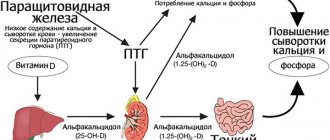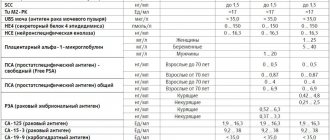10/16/2017 Olga Migunova
Prolactin is the name given to the hormone of the frontal part of the pituitary gland, which regulates lactation, the development of secondary sexual characteristics and is responsible for the normal functioning of the female reproductive system as a whole. Therefore, a deviation from the norm of prolactin in the blood of women may indicate a rather serious disorder in the body.
Norm prolactin
It is noted that the amount of this hormone does not always reflect the strength of clinical manifestations. For example, women with severe hyperprolactinemia may have regular menstruation, good ability to conceive and bear a child, and a slight excess of the norm may be combined with serious and unpleasant symptoms.
This phenomenon is associated with the existence of 4 different forms of the hormone:
- "small" BPD
- "big" BPD
- macro-PRL
- glycosylated PRL
All of these forms have different effects on target organs, so their identification is extremely important. Microprolactin is considered the most active; it is the one that causes all external manifestations of hormonal imbalance. Large forms of this substance are bound and therefore almost inactive.
Outside of pregnancy, a woman’s normal level of the hormone prolactin does not exceed 20 ng/ml (600 µU/ml). A rise in level to 1000 µU/ml is considered mild and insignificant. If hyperprolactinemia is detected, a macroprolactin test is additionally prescribed. If its amount exceeds 60%, then bioactive PRL is only 40%, which may well be within the normal range. If macroprolactin is low (less than 40%), then the active hormone is still outside the normal range and requires further examination.
Analysis results
Based on the transcript of the laboratory test data, the attending doctor will make a possible diagnosis and suggest the disease. For a final diagnosis, additional clarifying instrumental examinations will be required:
- general blood test and biochemistry (hemoglobin, sugar, bilirubin, urea, liver enzymes, cholesterol);
- hormone analysis (LH, FSH);
- Ultrasound of the thyroid gland;
- MRI of the pituitary gland.
Prolactin is normal
| among women | in men |
| 109-557 mIU/ml (4.79-23.3 ng/ml) | 73-407 mIU/ml (4.04-15.2 ng/ml) |
The values shown in the table are standard values, but they may vary between laboratories. The reason for the difference is in the test systems used and the features of the analyzers. When issuing results, a table of prolactin norms is always printed on the form.
It is not excluded that the analysis shows a significant excess of the norm, but no clinical manifestations are noted.
How does prolactin change in pregnant women?
Pregnancy is usually counted in trimesters - 3 trimesters of 4 weeks. Each is characterized by its predominant hormone. For example, in the first trimester, the maximum value is recorded for human chorionic gonadotropin, and the minimum for progesterone and total estrogen.
During pregnancy, the following gradually increases:
- 1st trimester – 23.5-94.0 ng/ml;
- 2nd trimester – 94.0-282.0 ng/ml;
- 3rd trimester – 188.0-470.0 ng/ml.
Disease dependence
Knowing the prolactin content, the doctor gets an initial idea regarding the provoking factor:
| Disease | Hormone level (ng/ml) |
| Macroprolactinoma | >500 |
| Microprolactinoma | 250-500 |
| Hormonally inactive pituitary adenoma | >200 |
| Functional hyperprolactinemia | 25-80 |
After treatment, it is necessary to undergo a control study to assess the dynamics. If the results do not change, the endocrinologist will change the treatment regimen.
Prolactin during pregnancy
As the day of birth approaches, the amount of estrogen in the blood of the expectant mother increases. This, in turn, stimulates the synthesis of PRL, the level of which increases several times, which is the absolute norm. Therefore, for pregnant women, this test is not informative and is not taken.
Nature has created such a mechanism so that by the time a child is born, a woman’s mammary glands are ready to secrete milk. PRL increases to its maximum at 25 weeks and decreases slightly before birth. With the first breastfeeding, prolactin levels increase in response to nipple stimulation.
Features of preparing and conducting a blood test for prolactin
To determine the amount of prolactin, venous blood is used, which is most often taken from the cubital vein. The doctor who ordered the blood test must explain how to properly prepare for the procedure, since the accuracy of the test result depends on this.
When preparing for a blood test for prolactin, you should adhere to the following recommendations:
- 24 hours before the study you need to avoid sexual intercourse;
- the day before the analysis, you need to wear soft underwear that will not irritate the nipples;
- the day before the analysis, you need to reduce physical activity and protect yourself from stress;
- do not drink alcohol the day before the test;
- A blood test for prolactin is taken strictly on an empty stomach. The last meal should be no later than eight hours before the blood test. Dinner the day before should consist of easily digestible food (yogurt, kefir, stew or vegetable salad);
- You need to get enough sleep before the test, so try to go to bed early. It is also recommended to donate blood no earlier than three hours after sleep;
- do not smoke two hours before blood sampling;
- come to the clinic 20-30 minutes before the appointed time to rest from the road and calm down, since even minor physical activity or anxiety can affect the level of prolactin in the blood.
It is also important to choose the right time of day to take a blood test, since the hormone prolactin is released unevenly throughout the day.
The most suitable time for taking blood is 8-10 am.
Also, the level of prolactin in the blood is affected by the phases of the menstrual cycle, so it is better to carry out the analysis between the fifth and eighth day after menstruation.
If a prolactin test was prescribed for a woman who has stopped breastfeeding, it is recommended to donate blood for testing 7-8 days after the baby was last put to the breast.
Hormone functions
Prolactin has many different effects on the female body. This is not surprising, because there are receptors for it in the mammary glands, ovaries, uterus, placenta, liver, eyes, lymphatic and immune cells, brain, kidneys, adrenal glands, intestines and pancreas.
Effects of BPD:
- Prepares the mammary glands for lactation
- Stimulates milk synthesis after childbirth
- In the second phase of the cycle, it supports the functioning of the corpus luteum, which produces progesterone.
- Takes part in the ovulation process
- Regulates the composition and volume of amniotic fluid
- Has immune properties
Hormone production and types
The main amount of prolactin is produced in the anterior lobe of the pituitary gland (adenohypophysis). This process is additionally controlled by the hypothalamus. The tissues of the central nervous and immune systems, placenta, and mammary glands also secrete this hormone in small quantities.
By its biochemical nature it belongs to peptide hormones, prolactin-like proteins. Almost all functions of the active substance are directly or indirectly related to reproduction . There are four forms of the hormone found in the body:
- monomeric prolactin (or “small” – molecular weight (MW) 22,000);
- dimeric (or “large” - MW 50,000);
- three-dimensional (or “very large” - MM 100,000);
- glycolyzed (MW – 25,000).
This transformation of the substance molecule is explained by the presence of three disulfide bridges, which give prolactin special chemical properties and the ability to undergo spatial modifications. Macroprolactin and monomeric substances exhibit different biological activities.
Monomeric prolactin has the highest degree of interaction with cell receptors; its share in the body is about 80%. The presence of a large number of other forms of the hormone in the blood makes it possible to diagnose pathological conditions; they are normally present in the blood of healthy people, but in small concentrations.
To date, not all functions of prolactin are known. This is due to its different biological activities, which directly depend on the isoform of the substance. In medicine, there is a hypothesis that manifestations of the peripheral functions of the hormone are associated with them, but this issue has not yet been thoroughly studied.
Symptoms of hyperprolactinemia
- Menstrual irregularities (infrequent or absent periods)
- Infertility (due to lack of ovulation or shortening of the 2nd phase of the cycle)
- Galactorrhea (leakage of milk from the breast) – occurs in 70% of cases
- Headache, loss of vision (with large pituitary tumors)
- Decreased libido
- Acne, facial hair growth (in 20% of patients)
- Osteoporosis
- Obesity (in 40-60% of cases)
- Depression, insomnia (in 20% of cases of hyperprolactinemia)
- Memory loss
Symptoms of increased concentration of prolactin in the blood
With an excess of the hormone prolactin in the body, serious functional disorders are observed (in both men and women):
- The early stages of the disease are characterized by a decrease in libido (sexual desire), which can provoke reproductive dysfunction.
- In women, the menstrual cycle fails and anorgasmia develops. During the examination, a lack of ovulation is detected. With high levels of the hormone prolactin, the production of FSH and LH decreases, which, in turn, leads to infertility.
- In men, sexual function is impaired; sexual intercourse is not accompanied by ejaculation. Spermogram analysis shows a small number of sperm, their motility is reduced, and various structural defects are observed.
In addition, high levels of the hormone prolactin in the blood can cause loss of vision, sleep and memory disturbances, depression, osteoporosis, mastopathy, and provoke such a dangerous condition as oncology of the mammary glands or other important female organs.
Reasons for increased prolactin levels
Physiological
| Pathological
| Taking medications
|
Physiological reasons
The amount of hormone in each individual woman varies throughout the day. It is known that during sleep the level of PRL increases, starting from 60-90 minutes. This occurs both during night rest and during daytime sleep, and after waking up the amount of the hormone drops sharply. A slight rise is also observed during physical activity, sexual intercourse, and also after eating protein foods. Stress reactions can also affect the hormone, especially when combined with physical stress (for example, fainting during a blood draw is a guarantee of an increase in PRL).
Pituitary gland diseases
Prolactinoma, a common tumor of the pituitary gland, is the most common cause of high levels of PRL in the blood. Depending on its size, it is called microprolactinoma (less than 1 cm) or macroprolactinoma (more than 1 cm). About a quarter of the world's population has undiagnosed pituitary microtumors, which do not cause significant symptoms and may simply be an incidental finding.
Most often, such adenoma is diagnosed in women aged 30-40 years. The female sex is characterized by the small size of the neoplasm. In addition to impairing reproductive function, the tumor can compress the visual pathways, leading to loss of vision, as well as cause headaches and impair quality of life. Therefore, with a proven adenoma (prolactin is higher than normal due to the microfraction, MRI shows a tumor), treatment with Dostinex or surgical removal is necessary (extremely rare). When planning a pregnancy, you need to take Dostinex for a year, then if you successfully try to conceive, stop the drug.
Other pituitary tumors
Any neoplasm that blocks the pathways between the pituitary gland and the hypothalamus can cause an increase in the concentration of PRL in the blood. Sometimes they are all combined under the term “pseudoprolactinoma,” although along with prolactin the amount of other hormones (GH, ACTH) also increases. Most of them have their own features on MRI and CT, but the number of PRL is much lower than in the case of true prolactinoma.
Primary hypothyroidism
The connection between decreased thyroid function and increased PRL in the blood has not yet been precisely explained. But almost half of patients with hypothyroidism have similar changes in tests. After starting replacement therapy, prolactin also returns to normal. We must not forget that hypothyroidism can easily coexist with brain tumors and other pathologies.
Polycystic ovary syndrome
The classic case of PCOS includes menstrual irregularities, ovarian cysts, and elevated androgen levels. But in 30-40% of cases, hyperprolactinemia is added to these signs. The reasons for this relationship are not precisely known. But for any suspicion of PCOS, it is necessary to take a test for prolactin and macroprolactin in order to prescribe the necessary treatment (see polycystic ovary syndrome).
Chest injuries
It is known that various surgical interventions can increase the PRL indicator for a period from a day (for abdominal surgery) to several months (for manipulations in the chest area). The same effect occurs with herpes zoster (Herpes zoster virus), which affects the skin of the upper body. This is due to increased nerve impulses from the damaged area to the brain. The closer the source of irritation is to the mammary glands, the more intense and durable these impulses are.
Idiopathic hyperprolactinemia
It happens that a moderate increase in the amount of the hormone in the blood (25-80 ng/ml) exists independently, without visible pathology of the hypothalamus and pituitary gland. Such cases are called idiopathic (causeless). Most people with this form of the syndrome have macroprolactinemia without needing treatment.
Hypothalamic diseases
The hypothalamus is one of the highest links in the endocrine system. Therefore, any disruption of its function leads to changes in the level of all hormones, including PRL. Hyperprolactinemia may result from a hypothalamic tumor, craniopharyngioma, glioma, inflammation in the brain, metastatic disease, and abnormal vascular development. A similar effect occurs with therapeutic irradiation of the brain.
Estrogen-producing tumors
Many neoplasms are capable of secreting hormones. In women, ovarian tumors often synthesize estrogen in large quantities. This leads to a natural increase in prolactin. Therefore, such changes in tests are a reason to examine the pelvic area with an ultrasound.
Taking medications
Sometimes prolactin in women is increased when taking certain medications: antipsychotics (haloperidol, aminazine), antiemetics (cerucal, moltilium), reserpine, levodopa, opiate substances (morphine), verapamil, hormonal contraceptives.
Reduced prolactin in women
Low prolactin in women may be due to the following reasons.
Causes of low prolactin
Sheehan's syndrome (necrosis of the pituitary gland due to bleeding during labor), taking certain medications, post-term pregnancy, tumors and brain tuberculosis. Hypoprolactinemia can be caused by dopaminomimetics, some antibiotics and antitumor drugs, antiparkinsonian drugs, hormonal drugs, and drugs. Reduced prolactin in women is manifested by menstrual irregularities, obesity, and emotional lability.
Symptoms of low prolactin
- Small amount of breast milk.
- Delayed puberty in teenage girls.
- Miscarriage (early miscarriages).
- Problems with conception.
- Sleep disorders.
How to increase prolactin in a woman
Often women have a question about how to increase prolactin through nutrition. This is possible by correcting the intake of carbohydrates and fats in the body. Cereals, dairy products, fatty fish, pasta and baked goods made from durum wheat, quinoa seeds and sesame are added to the diet. Traditional medicine recommends decoctions of fenugreek and whole grain oats. They increase hormone production.
How to lower prolactin levels in a woman. Photo: en.tgchannels.org
Doctors of traditional medicine advise using these recommendations when there is a physiological decrease or as an addition to the main treatment. Before starting therapy, consultation with a specialist is necessary; you should not start taking herbal decoctions on your own. If the decrease in the hormone is due to physiological reasons (post-term pregnancy), then its level will recover over time; drug treatment is not required. To activate breast milk production, herbal infusions are used, diet is adjusted, and psychotherapy is carried out with training in relaxation methods.
Hypoprolactinemia caused by drugs is eliminated by discontinuing them. If the pathology is based on a brain tumor, then surgical removal with radiation therapy is prescribed. Tactics are individual, depending on the size of the tumor, its location, and malignancy. If necessary, hormone replacement therapy is prescribed after surgery. For Sheehan syndrome, various hormonal drugs are used for treatment. The choice depends on which hormone deficiency or excess causes a decrease in prolactin. With Sheehan syndrome, traditional medicine and self-medication are prohibited.
Reasons for decreased prolactin levels
- Pituitary infarction after childbirth
- Taking medications
Pituitary infarction (Sheehan syndrome)
During pregnancy, a woman's pituitary gland increases in size, but its blood supply does not improve. Therefore, massive blood loss or a drop in pressure during labor can lead to a heart attack of this important organ. As a result, pituitary cells die and there is a deficiency of hormones, including prolactin. In such patients, prolactin levels in tests are low, so breastfeeding is impossible. If the volume of the pituitary gland that has undergone necrosis is too large, then the woman will need replacement therapy.
Taking medications
Some medications and substances can reduce hormone secretion: dopamine, pyridoxine, diuretics, nicotine. The latter explains problems with breastfeeding when smoking, when prolactin is below normal.
How to reduce the concentration of the hormone prolactin in the blood?
If a specialist diagnoses an increased level of prolactin in the body, treatment should begin immediately. Therapeutic measures are aimed at combating the disease that caused the development of hyperprolactinemia. Thus, prolactinoma involves drug treatment using a drug such as Bromocriptine and other drugs, radiation therapy for a pituitary tumor or its surgical removal. In case of hypothyroidism, treatment of thyroid pathology is necessary, and so on.
Additional examination
If a blood test shows three times that the amount of PRL is not normal, then additional tests are usually performed:
- History of medication use
- Assessment of thyroid function (TSH, free T4)
- CT, MRI of the pituitary gland and hypothalamus
- Ultrasound of the pelvic organs
- Assessment of liver and kidney function (biochemical blood test, ultrasound)
- Hormonal profile (FSH, androgens, estradiol)
Any changes in a woman’s hormonal profile are indications for further examination. If there are deviations only in the numbers on the form, and there are no symptoms at all, then treatment is most likely not required.
Author:
Evtushenko Anna Aleksandrovna obstetrician-gynecologist
Why does the amount of prolactin in the blood decrease?
A reduced concentration of this hormone in the body is considered normal for children, men and non-pregnant women. A decrease in the amount of prolactin in the blood, as a rule, does not require special treatment. However, to exclude diseases of the pituitary gland, it is still worth undergoing a medical examination.
A low level of prolactin in the blood may indicate:
- benign and malignant tumors of the pituitary gland;
- pituitary tuberculosis;
- head injuries with dysfunction of the pituitary gland.
Also, the level of the hormone in question decreases due to radiation therapy for a pituitary tumor, long-term use of certain medications (Dopamine, Levodol, etc.).
Diagnostic methods
The main method to detect abnormalities at an early stage will be a blood test. If the indicator is elevated, triple testing is carried out to exclude a false positive result.
If samples taken three times show a deviation, this will mean that there is a pathological process in the body, accompanied by a hormonal imbalance.
To identify the cause, patients undergo:
- Inspection and survey. Based on characteristic complaints, one can determine: the cause of deviations in the pathology of the pituitary gland or the failure caused diseases of the reproductive sphere.
- The ratio of thyroid hormones, adrenal cortex and pituitary gland. Previously, a special calculator was used for such research and the analysis was not done for everyone due to the high cost. Now hormonal structures are calculated by an electronic device and the price is affordable for almost everyone. And in some clinics, a child or teenager can donate blood for testing for free.
- Visiting a gynecologist (for women) and a urologist (for men). A common cause of hyperprolacteria is inflammation or tumors in the reproductive organs.
If doctors suspect that the cause is pituitary tumors, they conduct a full examination of this organ.
For additional diagnostics, patients are prescribed CT or MRI of the brain, ultrasound and a number of other studies. In order for treatment to be successful, it is necessary not only to reduce prolactin, but also to eliminate the provoking factor. A comprehensive examination allows you to select effective medications to correct hormones and reduce the risk of complications.
How is treatment carried out for elevated
Therapy depends on the pathological factor that provoked the hormonal imbalance:
- Pituitary malignant neoplasms. The tumor is removed or chemotherapy and radiation therapy are used.
- Benign pituitary tumors are treated with Seroctipine, Parlodel, Bromocriptine and other dopamine antagonists.
- Diseases of the hypothalamus are treated with medications (the names of the medications are the same as for the pituitary gland) or surgery.
- Polycystic ovary syndrome is eliminated under the supervision of gynecologists, who select the necessary therapy.
In addition to eliminating the cause, the following drugs are used to correct the prolactin background:
- "Dostinex";
- "Norprolac".
In addition to medications for hormonal correction, patients are prescribed vitamin therapy, dietary supplements and other means for general strengthening of the body.
During therapy, it is necessary to donate blood several times to monitor the progress of treatment. This will allow you to evaluate the effectiveness of the therapy and, if necessary, replace ineffective drugs.
It is important to remember that medications used to reduce prolactin should not be taken together with alternative medicine. Taking medications and herbs together can cause increased hormonal imbalance. Therefore, in order not to harm your health, you do not need to look on online forums for additional ways to bring the hormone back to normal.
Treatment
Prolactin concentrations can be stabilized using drug therapy, traditional medicine, and lifestyle adjustments. The treatment regimen depends on the diagnosed root cause of the disease, so a set of therapeutic measures is selected individually.
In case of minor deviations from the norm and in the absence of pathologies of internal organs, drug therapy is not required. You need to follow simple rules:
- sufficient physical activity, special practices (for example, yoga);
- weight normalization;
- proper nutrition, enriched with vitamins and minerals;
- eliminating stress factors.
If the levels are too high, drug therapy is prescribed. The drug and its dosage are determined only by the doctor. If the increase in hormone levels is associated with prolactinoma, surgery is performed to remove the tumor.
In folk medicine there are no recipes that are directly aimed at regulating hormone levels . Herbal medicinal raw materials have a symptomatic effect, have a sedative effect, or are aimed at reducing weight.
There are no special therapeutic measures to correct low prolactin; only symptomatic treatment is carried out.
Signs
Finding symptoms and making a diagnosis is the doctor's job. But the patient should also pay attention to his condition in order to promptly recognize the signals that the body gives in the event of a hormonal imbalance.
Here is a list of some signs that indicate that prolactin levels are not normal:
- discharge from the breast, both in women and men;
- weight gain;
- inability to conceive a child for several years;
- decreased sexual desire (libido, potency);
- blurred vision;
- psycho-emotional symptoms - sleep disturbances, anxiety, lethargy;
- headaches and dizziness;
- amenorrhea (cessation of menstruation), or a change in the nature of menstruation - the appearance of pain, an irregularity in the length of the cycle, heavy bleeding;
- hirsutism in women (appearance of hair where it should not be - face, stomach, chest);
- acne;
- deterioration of teeth and frequent fractures, even osteoporosis.
It is worth knowing that the body of each individual person is individual. Therefore, signs of hormonal imbalance may vary from person to person. A hormone such as prolactin can affect almost any part of the body, so its fluctuations are characterized by a very diverse set of symptoms.
What to do in case of deviation from the norm
If the test results do not coincide with the norm, a second consultation with a doctor is necessary. Depending on the level of prolactin, he will prescribe further studies that will help identify possible causes of the deviation.
These methods include:
- Computed tomography (CT), magnetic resonance imaging (MRI), x-ray.
- Ultrasound (ultrasound examination) of the thyroid gland.
- Donating blood for biochemistry and additional hormones determined by the doctor (TSH - thyrotropin, FSH - follitropin, LH - luteotropin, and so on).
- For women - a pregnancy test, blood sampling for hCG (human chorionic gonadotropin).
Depending on the results obtained, appropriate treatment is prescribed. As a rule, it is medicinal. The choice of medications depends on the reasons for changes in prolactin levels. These may be analogues of thyroid or adrenal hormones, tamoxifen (increases sensitivity to estrogen). To suppress prolactin, dopamine antagonist drugs are used, such as dostinex, parlodel, bromocriptine. These medications are used to lower the level of the hormone in the blood.
In cases where it is not possible to reduce the size of the pituitary adenoma with medications, radiation therapy is prescribed.
If the tumor does not respond to the previous method, the adenoma is surgically removed. But the use of this method is very rare, since taking medications is usually sufficient.
It is necessary to take into account that in some cases medications are prescribed for life. But even if the treatment is just a course, if hormonal imbalances are detected, it is necessary to undergo appropriate tests every few months in order to monitor possible relapses.











